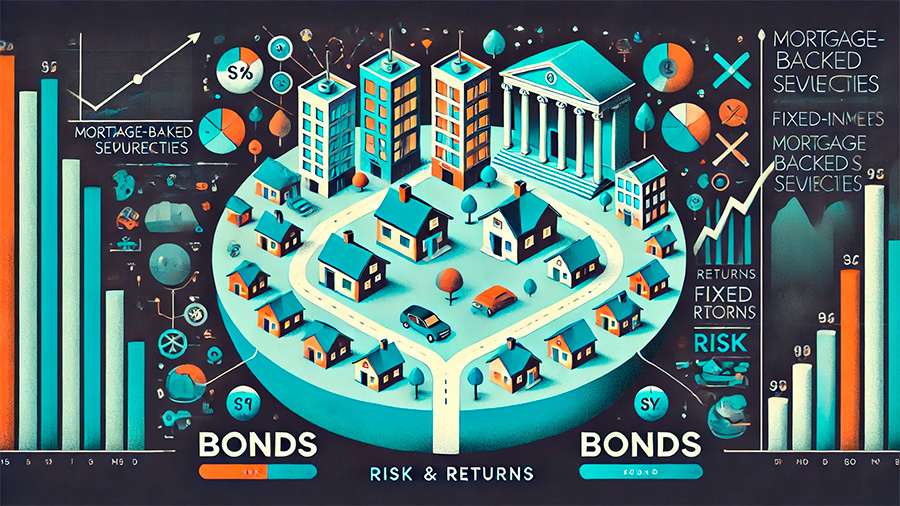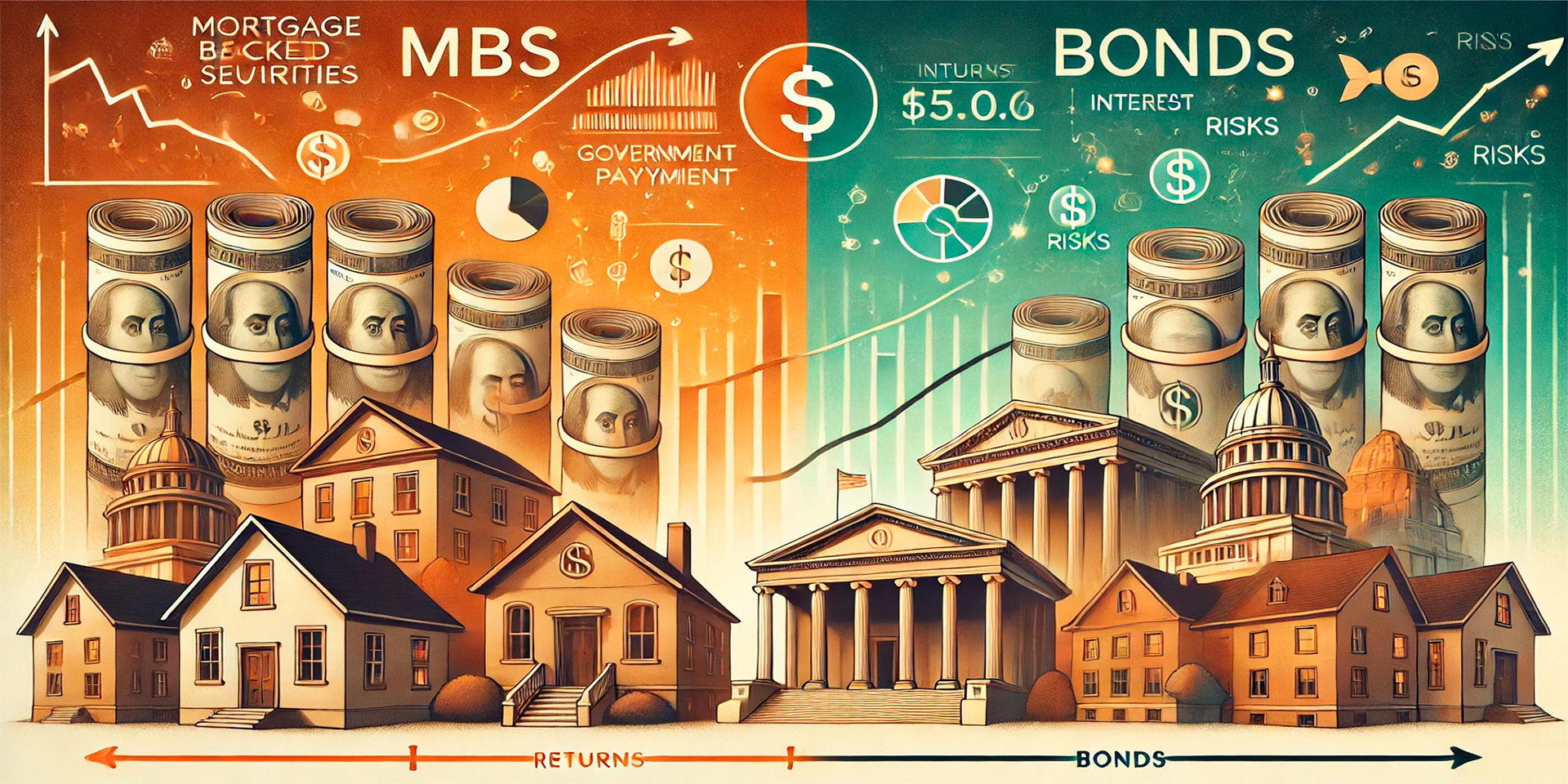Mortgage-backed securities (MBS) and bonds are both popular fixed-income investments, offering investors a way to generate steady returns with relatively lower risk compared to stocks. However, while they share similarities, they also have distinct differences in structure, risk profiles, and how they generate returns. Choosing between MBS and bonds depends on your investment goals, risk tolerance, and market outlook.
Mortgage-backed securities are a type of asset-backed security that pools together a collection of home loans, allowing investors to earn returns from the payments made by borrowers. Bonds, on the other hand, are debt securities issued by governments or corporations to raise capital, and they pay interest to bondholders over time. This article compares MBS and bonds, exploring their differences, risks, and benefits to help you decide which is the better investment for your portfolio.
What Are Mortgage-Backed Securities (MBS)?
Mortgage-backed securities are investment products created by bundling home loans into a single security. These home loans are typically issued by banks or financial institutions and then sold to government-sponsored enterprises (GSEs) like Fannie Mae or Freddie Mac, or to private institutions, which package them into MBS. Investors in MBS receive regular payments that come from the homeowners’ mortgage payments, including both principal and interest.
How MBS Work
When you invest in MBS, you are essentially buying a portion of a pool of mortgages. The cash flows from these mortgages—both the principal and interest payments—are distributed to investors. The performance of MBS depends on the repayment behavior of the borrowers whose loans are included in the security.
Types of MBS: There are two main types of MBS—pass-through securities and collateralized mortgage obligations (CMOs). In pass-through securities, mortgage payments are distributed directly to investors. CMOs, on the other hand, divide the mortgage pool into tranches, which vary in risk and return based on the order in which investors are repaid.
Government-backed MBS: Many MBS are issued by government-sponsored enterprises (GSEs) such as Fannie Mae, Freddie Mac, or Ginnie Mae. These MBS are seen as lower risk because they carry the implicit or explicit backing of the U.S. government, ensuring that investors will be paid even if borrowers default.
MBS provide regular income through mortgage payments, making them attractive for income-seeking investors, but they also carry unique risks.
Key Benefits of MBS
Mortgage-backed securities offer several advantages to investors, particularly those seeking regular income and exposure to the housing market.
Regular income: Like bonds, MBS provide consistent payments, which can be appealing to income-focused investors. Payments typically consist of both interest and principal, offering a steady cash flow.
Diversification: MBS offer diversification within the fixed-income portion of a portfolio by providing exposure to the housing market. This can be beneficial for investors who already have significant exposure to traditional bonds or equities.
Government backing: Many MBS are backed by government agencies like Fannie Mae and Ginnie Mae, reducing the risk of default and making these securities safer compared to other debt instruments.
However, MBS also have some risks, particularly when it comes to prepayment risk and interest rate sensitivity.
Risks of MBS
While MBS offer attractive yields, they come with specific risks that investors need to consider before investing.
Prepayment risk: One of the key risks associated with MBS is prepayment risk. Homeowners can prepay their mortgages, especially when interest rates fall, which means MBS investors may receive their principal back sooner than expected and need to reinvest in a lower-rate environment.
Interest rate risk: Like bonds, MBS are sensitive to interest rate fluctuations. When interest rates rise, the value of MBS typically falls, as newer securities may offer higher yields. Additionally, higher rates may reduce mortgage prepayments, lengthening the duration of MBS.
Credit risk: While government-backed MBS are considered relatively safe, private-label MBS (those not issued by GSEs) can carry higher credit risk, as they may include mortgages from borrowers with lower credit scores or other riskier characteristics.
Understanding these risks is essential for determining whether MBS are a suitable addition to your investment portfolio.

What Are Bonds?
Bonds are fixed-income securities issued by governments, corporations, or other entities to raise capital. When you invest in a bond, you are essentially lending money to the issuer in exchange for regular interest payments, known as coupon payments, and the return of your principal when the bond matures. Bonds come in a variety of types, including government bonds, corporate bonds, and municipal bonds.
How Bonds Work
Bonds are relatively straightforward: the issuer borrows a set amount of money from investors for a specific period of time at a fixed or variable interest rate. During this time, the bondholder receives regular interest payments, and at the end of the term (the maturity date), the issuer repays the bondholder the full principal amount.
Types of bonds: There are several types of bonds, including:
Government bonds: Issued by national governments, such as U.S. Treasury bonds, these are considered one of the safest investments due to the backing of the federal government.
Corporate bonds: Issued by companies to raise capital, these bonds typically offer higher yields than government bonds but come with greater risk.
Municipal bonds: Issued by state or local governments, municipal bonds are often tax-exempt, making them attractive to certain investors.
Credit rating: Bonds are rated by credit rating agencies, such as Moody’s and S&P, which assess the creditworthiness of the issuer. Higher-rated bonds (investment-grade) are considered safer, while lower-rated bonds (junk bonds) offer higher yields but carry more risk.
Bonds are a cornerstone of fixed-income investing, providing stability, income, and lower risk compared to equities.
Key Benefits of Bonds
Bonds are popular with conservative investors looking for regular income and capital preservation. They offer a range of benefits that make them an attractive option for many portfolios.
Stable income: Bonds provide regular, predictable interest payments, which can be ideal for investors seeking income stability, such as retirees.
Capital preservation: Bonds are generally considered less risky than stocks, making them a safer investment for capital preservation. Government bonds, in particular, are seen as nearly risk-free.
Diversification: Adding bonds to a portfolio can reduce overall volatility, as they often perform well during periods of stock market downturns.
Bonds offer stability and income, but their lower yields may not be appealing to investors seeking higher returns.
Risks of Bonds
While bonds are considered relatively safe, they are not without risks. Investors need to be aware of potential pitfalls when investing in bonds.
Interest rate risk: Like MBS, bonds are sensitive to changes in interest rates. When interest rates rise, the value of existing bonds falls, as new bonds offer higher yields. This can lead to losses if bonds are sold before maturity.
Credit risk: Corporate and municipal bonds carry credit risk, meaning the issuer could default on payments. Higher-yield bonds, like junk bonds, are particularly vulnerable to this risk.
Inflation risk: Bonds provide fixed payments, which can be eroded by inflation. As the cost of living rises, the purchasing power of the interest payments decreases.
Bonds are often considered a safe haven, but their performance can be negatively impacted by changes in interest rates, inflation, and credit conditions.

MBS vs. Bonds: Key Differences
While both MBS and bonds are fixed-income investments, there are several important differences between the two that investors should consider when deciding which option is best for their portfolio.
Income Streams
MBS: Mortgage-backed securities generate income from the interest and principal payments made by homeowners. As such, they offer monthly or quarterly payments that include both interest and a portion of the principal.
Bonds: Bonds typically offer fixed interest payments (coupon payments) on a semi-annual or annual basis. At maturity, bondholders receive the full principal back, providing more predictability in terms of income.
MBS tend to offer higher yields compared to traditional bonds, but they also come with more complex cash flows due to the inclusion of principal repayments.
Risk Profiles
MBS: The primary risks associated with MBS are prepayment risk and interest rate risk. The value of MBS can fluctuate based on homeowners’ behavior, such as refinancing or paying off their mortgages early.
Bonds: Bonds are generally seen as lower risk than MBS, particularly government bonds. However, bonds are still subject to interest rate risk and credit risk, especially for lower-rated corporate or municipal bonds.
MBS may offer higher returns but carry more uncertainty due to the potential for early mortgage repayments, while bonds, especially government bonds, provide more stable income.
Market Sensitivity
MBS: Mortgage-backed securities are sensitive to changes in the housing market and interest rates. When rates rise, mortgage refinancing decreases, potentially lengthening the duration of MBS. Conversely, falling interest rates can lead to more prepayments, reducing the duration.
Bonds: Bonds are primarily influenced by interest rate movements and the creditworthiness of the issuer. Rising rates cause bond prices to fall, while falling rates increase bond prices.
Both MBS and bonds are interest rate-sensitive, but MBS are also affected by fluctuations in the housing market.
Which Is the Better Investment?
Deciding whether MBS or bonds are the better investment depends on your financial goals, risk tolerance, and market outlook. Both offer fixed income and diversification benefits, but they cater to different types of investors.
When to Choose MBS
Mortgage-backed securities may be the right choice for investors seeking higher yields and regular income, particularly those who are comfortable with the complexities of mortgage payments and prepayment risk. MBS are well-suited for income-focused investors looking to diversify their fixed-income portfolios with exposure to the housing market.
Income-focused investors: If generating steady cash flow is a priority, MBS offer higher yields than many traditional bonds, though they come with more uncertainty.
Housing market exposure: MBS provide indirect exposure to the housing market, making them a good option for investors looking to capitalize on the strength of the real estate sector.
When to Choose Bonds
Bonds are typically a better fit for conservative investors seeking capital preservation, stability, and lower risk. Government bonds, in particular, offer near-risk-free returns, making them ideal for those who prioritize safety over yield.
Capital preservation: For investors who prioritize preserving capital and minimizing risk, government bonds offer security and stable returns.
Lower risk tolerance: If you’re risk-averse or looking for a safer investment, bonds—especially highly rated government and corporate bonds—are a more reliable option than MBS.
Ultimately, whether MBS or bonds are the better investment depends on your financial situation, goals, and appetite for risk. Both have their merits, and many investors choose to hold a mix of both to balance income and risk across their portfolios.
By understanding the differences between these two types of fixed-income investments, you can make more informed decisions and create a diversified portfolio tailored to your investment needs.




